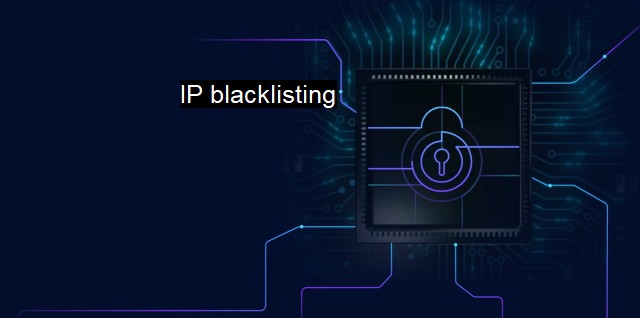What is IP blacklisting?
Securing the Internet: Understanding IP Blacklisting as a Key Strategy Against Cyber Threats
IP blacklisting refers to a mechanism by which server administrators block unwanted access by users of specific IP addresses. This method of blocking traffic to servers stems from identifying malicious behavior or infringements by a user at a particular IP address. IP blacklisting is widely used within cybersecurity and antivirus initiatives to protect networks and systems from harmful online activities.IP blacklisting becomes critical within the broader cybersecurity landscape because of its potential to safeguard systems from cyber threats. The act of blacklisting an IP categorically prohibits this IP address from communicating with your server. When an IP's activities are deemed malicious, whether based on spam reports or detected irregularities by a firewall or antivirus program, this IP is added to a blacklist to prevent further adverse actions.
Several databases globally maintain records of IP addresses flagged for nefarious engagement. These may consist of violations such as spamming, phishing attempts, employing bots to conduct massive login attempts, other types of brute-force attacks, or distributing malware.
An antivirus program strengthens its protective mechanism by incorporating an IP blacklist. When robust antivirus software identifies an incoming interaction from a blacklisted IP address, it quickly intercepts and restricts the connectivity. This is aimed at preventing any potential threat from infiltrating the system, ensuring consistent system functionality devoid of potential harm.
Simultaneously, antivirus software also monitors outgoing communications, recognizing connections aimed at IP addresses marked in a known blacklist. The antivirus program alerts the system user and appropriates corrective measures immediately, reducing the vulnerability of the system to malware, botnets, and harmful program download attempts.
In the protection of unbeknown IT infrastructure, IP blacklisting is invaluable. For system administrators guarding against network breaches, patterns of cyber threats can originate from a specific rogue address. Identifying, reporting, and blacklisting these addresses is the quickest way to shut down these rogue addresses, reducing the probability of a more significant system violation.
While IP blacklisting provides numerous benefits, it also entails a few unfortunate situations. False-positives might emerge, where a legitimate user's IP is erroneously blacklisted. In such cases, it could disrupt genuine engagements by reputable users impeding vital communications. IP-based threats often change their IP addresses, making the onus of maintaining an up-to-date blacklist a constant source of tension on cybersecurity administrators.
This also means that IP blacklisting cannot be the only protective measure, given the ease of cybercriminals swiftly altering their IP addresses. IP blacklisting must rather be leveraged in conjunction with other cybersecurity processes like - Intrusion Prevention System (IPS), firewalls, and antivirus software.
Measures should also be in place for entities to confirm their blacklist status and to appeal if they believe they have been incorrectly flagged. This ability facilitates the correction of false positives and ensures fair and equitable application of IP blacklisting.
IP blacklisting holds essential placed within cybersecurity setup and enables real-time prevention from encountering dangerous cyber disruptors. with an evolving threat landscape, IP blacklisting must not be treated as a standalone protective measure, but rather as a key component in a multifaceted cybersecurity strategy.
IP blacklisting is an important tool in antivirus initiatives and cybersecurity in general. Despite its limitations, it still provides considerable protection to digital infrastructure by impeding harmful connections of known malicious actors or sources. Like all protective systems, it must continuously evolve and adapt to the constant flux of threats surfacing from cybercrime entities, particularly spear-phishing and ransomware actors.

IP blacklisting FAQs
What is IP blacklisting in cybersecurity and antivirus?
IP blacklisting is the process of blocking a specific internet protocol (IP) address from accessing a particular network or website due to suspicious or malicious activities detected by cybersecurity or antivirus software. It is a measure to prevent cyberattacks and safeguard networks and websites from potential threats.What are the reasons for an IP address to get blacklisted?
There are various reasons why an IP address may get blacklisted. It could be due to suspicious or malicious activities such as hacking attempts, spamming, viruses, or malware infections. An IP address may also get blacklisted if it is found to be a source of phishing scams, spreading malicious content, or violating the terms of the website or network.What are the consequences of being blacklisted?
Being blacklisted can have severe consequences, such as loss of access to the website or network, reduced website traffic, diminished customer trust, and damage to the online reputation. It can also lead to financial losses if the blacklisted IP is used for business purposes. Moreover, it may take considerable time and resources to get the IP address removed from the blacklist.How can I prevent my IP address from getting blacklisted?
To prevent your IP address from getting blacklisted, it is essential to follow best practices for cybersecurity and antivirus. This includes using strong passwords, regularly updating software and applications, avoiding clicking on suspicious links or emails, and installing antivirus and firewall software. It is also crucial to monitor and address any suspicious or unusual activities on the network immediately to prevent potential threats.| | A | | | B | | | C | | | D | | | E | | | F | | | G | | | H | | | I | | | J | | | K | | | L | | | M | |
| | N | | | O | | | P | | | Q | | | R | | | S | | | T | | | U | | | V | | | W | | | X | | | Y | | | Z | |
| | 1 | | | 2 | | | 3 | | | 4 | | | 7 | | | 8 | | |||||||